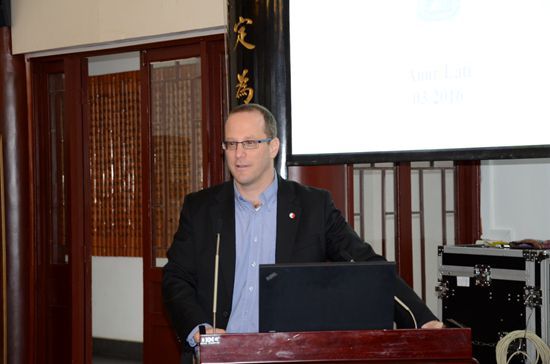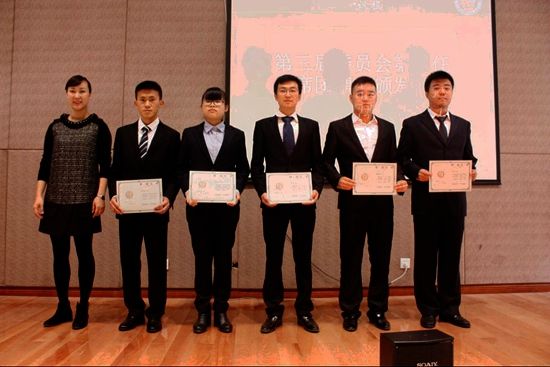我校客座教授天体物理学家Stefanie Komossa(斯蒂芬尼·柯莫萨)教授作为合作者,以我校为她署名单位在英国《自然》 (Nature Astronomy)杂志上发表了题为The stellar disruption of a star by the tidal forces of a black hole”的科学亮点论文,这是我校作为合作单位首次在国际顶级刊物《自然》杂志上发表署名学术论文。
我校2016年3月,依托世界最大单天线射电望远镜FAST,成立了物理与天文系,并在去年开设了贵州省第一个天文学本科班,聘请了包括Stefanie Komossa教授在内的一批知名教授,该文章的发表将极大提升我校在天文学科显示度。
利用美国宇航局和欧洲空间局的空间X射线望远镜,斯蒂芬尼·柯莫萨参与的国际合作研究小组,发现了一个显著的潮汐瓦解事件(TDE),未来,能够利用FAST作进一步的研究,石云辉校长说:“很有可能,未来我校首届天文班中的学生能利用FAST作出类似的新发现,那将是我们极大的荣耀。”
2月6日,论文在《自然-天文学》正式发表(http://lanl.arxiv.org/abs/1702.00792),当天,NASA(美国宇航局)就此重大天文发现举办了新闻发布会(详见链接:http://chandra.si.edu/blog/node/631
http://chandra.si.edu/press/17_releases/press_020617.html
http://chandra.si.edu/photo/2017/tidal/)。
这幅图描绘的现象被天文学家称之为“潮汐瓦解事件(TDE)”。 当一个物体,譬如一个恒星,接近一个黑洞时,会被黑洞强大引力产生的潮汐力所破坏。 在一个“潮汐瓦解事件”中,一些恒星碎片以高速向外抛出,而剩余的部分(图中红色显示)将落向黑洞,在其下落过程中将变得越来越热,产生显著的X射线耀斑。右下角两个插图分别显示了在可见光和X射线波段光的耀斑事件。
Stefanie Komossa(斯蒂芬尼·柯莫萨)教授执笔撰写的英文报道原文及林达成博士(论文第一作者)翻译译文如下:
BLACK HOLE DISRUPTS A WHOLE STAR.
Discovery made by NASA’s and ESA’s X-ray observatories in space.
A giant black hole ripped apart a star and then gorged on its remains for about a decade, according to an international team of astronomers, who published their discovery in the JournalNature Astronomytoday. The team involves a visiting professor from QianNan Normal University for Nationalities. The finding is based on the discovery of a very luminous and long-lasting flare of high-energy radiation, detected with space-based observatories: NASA’s Chandra X-ray Observatory and Swift satellite as well as ESA’s XMM-Newton.
The trio of orbiting X-ray telescopes found evidence for a “tidal disruption event” (TDE), wherein the tidal forces due to the intense gravity from a black hole can destroy an object – such as a star – that wanders too close. During a TDE, some of the stellar debris is flung outward at high speeds, while the rest falls toward the black hole. As it travels inwards to be ingested by the black hole, the material heats up to millions of degrees and generates a distinct X-ray flare.
The extraordinary long bright phase of this event spanning over ten years means that among observed TDEs this was either the most massive star ever to be completely torn apart during one of these events, or the first where a smaller star was completely torn apart.
The event is located in a small galaxy about 1.8 billion light years from Earth. It was noted, when it became at least a factor 100 brighter in X-rays, and then remained at its remarkable brightness for more than a decade. The stream of stellar debris rapidly falls onto the black hole at a high rate, thereby feeding the black hole with the stellar remains.
This TDE may help answer the question as to how supermassive black holes in the early universe grow. If supermassive black holes can grow from TDEs or other means at a very fast rate, this could explain how supermassive black holes were able to reach masses about a billion times higher than the sun when the universe was only about a billion years old.
“In the near future, the world’s largest single-dish radio observatory,FAST, located in QianNan prefecture, can be used to study the radio signals from stellar disruptions by black holes,” said Dr. Ligong Mi, acting head of the newly established department of Physics and Astronomy at QNUN. The department was launched last March, just before the FAST inauguration, “It is likely, and would be our great honor, if such future discoveries will be made by some of the first astronomy students from QNUN at the home province of FAST”, added President (Yunhui) Shi from QNUN.
A paper describing the results appears in Nature Astronomy on February 6th and is available online https://arxiv.org/abs/1702.00792.
Contact for further information:
Dr. Dacheng Lin, email: dacheng@dachenglin.com
First author of theNaturepublication
Dr. Stefanie Komossa, email:astrokomossa@gmx.de
Visiting Professor at QNUN and co-author of the publication
Dr. Ligong MI, miligong@sgmtu.edu.cn
Acting Head, Department of Physics and Astronomy at QNUN
黑洞完全撕碎一恒星
——由美国航天局和欧洲航天局的X射线观测卫星发现。
根据一个由多国天文学家组成的国际团队,一个巨大的黑洞撕碎了一颗恒星,然后拼命地吞噬其遗骸大约十年。他们的这一发现今天发表在“自然天文学杂志”上。该团队包括黔南民族师范学院的一名客座教授。这一发现是基于探测到一个非常持久而明亮的高能辐射耀斑。 该耀斑被美国航天局的钱德拉X射线望远镜和雨燕卫星以及欧空局的XMM-牛顿卫星检测到。
在轨的这三个X射线望远镜发现的这个“潮汐瓦解事件”(TDE)是指由于黑洞的强烈的引力而引起的潮汐力撕碎了过于接近的物体,比如恒星。恒星被撕碎后,一些恒星碎屑会被高速抛出逃离黑洞,而其余的碎屑则会被吸向黑洞。当越来越接近并最终吸进黑洞时,恒星碎片会被加热到几百万度并发出奇特的X射线耀斑。
领导这项研究的位于新罕布什尔州达勒姆市的新罕布什尔大学的林达成说,“我们目睹了一颗恒星悲观而漫长的死亡。自20世纪90年代以来,天文学家已经发现了几十次潮汐瓦解事件,但是它们持续的时间远没有这个久。”
这个耀斑能维持十多年并一直很亮意味着它是所有探测到的潮汐瓦解事件中,要么是被完全撕碎的恒星中最大的一个,要么是第一个被完全撕碎的恒星。
这个X射线耀斑(缩写为XJ1500 + 0154)来自距离地球约18亿光年的小星系中。
这个X射线耀斑被发现是因为比以前至少亮了100倍,然后保持在其显著的亮度十多年。恒星碎片流以高速率快速落到黑洞上,从而向黑洞馈送恒星残留物。
哈佛 - 史密森天体物理中心的合作者James Guillochon说,“在我们观测到的大部分时间里,这个黑洞在迅速增长。这告诉我们一个不寻常的东西 - 比如一个明星比我们的太阳重两倍 - 被送入黑洞。”
这个事件可以帮助回答早期宇宙中超大质量黑洞如何形成的问题。如果超大质黑洞可以从潮汐瓦解事件或其他方式快速生长的话,这就可以解释为什么超大质量的黑洞能够在宇宙只有十亿岁时质量就比太阳高出约十亿倍。
“这个事件表明,黑洞真的可以以非常快的速度增长,”来自中国都匀市的黔南民族师范学院的合着者Stefanie Komossa说。 “这可能有助于了解超大质量黑洞如何过早形成。”
根据研究人员的模型,供给给黑洞的恒星饲料在未来十年会显着减少。这将导致XJ1500 + 0154在未来几年的X射线亮度衰减。
“我相信未来,可以利用位于黔南布依族苗族自治州的、世界最大射电望远镜500口径球面射电望远镜,研究来自黑洞撕裂恒星发出的射电信号。”黔南民族师范学院物理和天文学系主任(代)米立功博士说。黔南民族师范学院物理与天文系成立于2016年3月,刚好在FAST落成启用之前。黔南民族师范学院石校长说“很有可能,未来我校首届天文班中的学生能利用FAST作出类似的新发现,那将是我们极大的荣耀”
报道这些结果的论文发表在2月6日的自然天文学杂志上(通过下面链接可获取文章内容:http://lanl.arxiv.org/abs/1702.00792)。
需要了解进一步的信息可与相关人员联系:
林达成博士(论文第一作者),电子邮件:dacheng@dachenglin.com
Stefanie Komossa博士(黔南民族师范学院客座教授和论文合作者),电子邮件:astrokomossa@gmx.de
米立功博士(QNUN物理和天文学系主任(代)),电子邮件:miligong@sgmtu.edu.cn
下一篇::我校召开改革发展座谈会
- 我校2017年“大门生禁毒自愿者走进万户家庭”专项举措服务团运动纪实一
- 我校2017年“大门生禁毒自愿者走进万户家庭”专项举措服务团运动纪实二
- 我校第三届“幼专之夏”艺术节胜利终结
- 中国科学院院士王跃飞教授到我校考察
- 我校退休职工在州老干部运动中捷报频传
- 贵州省社科联到我校开展调研工作
我有话说
成人高考
最新文章
- 1医学系师生开展暑期“三下乡

2017年7月12日,医学系“黔医筑梦”社会实践......
- 2我校2017年“大门生禁毒自愿

2017年7月初,由我校组织成立的“大学生禁毒......
- 3我校2017年“大门生禁毒自愿

由我校14名大学生志愿者组成的黔南民族医专......
- 42017年三下乡专题报道黔南医

由校团委组织开展的学校2017年暑期科技文化......
- 52017年三下乡专题报道黔南医

2017年7月5日,校团委在新校区礼堂举行学校2......
推荐文章
热门文章
- 1我校科技园与贵州智慧山地农业发

贵大新闻网讯(校科技园邬敏报道|摄影陈佳琪...
- 2以色列驻成都总领事馆领事蓝天铭

贵大新闻网讯(记者团陈飞宇实习记者张吴云报...
- 3我校社团联合会第三届委员会第三

贵大新闻网讯(记者团严纯实习记者王佳文郑婷...
- 4贵大健儿在第十六届全国大学生田

贵大新闻网讯(记者团苏明明报道|摄影任贵罗...
- 5贵州省公共大数据重点实验室研究

贵大新闻网讯5月26日,由贵州省科技厅组织召...

